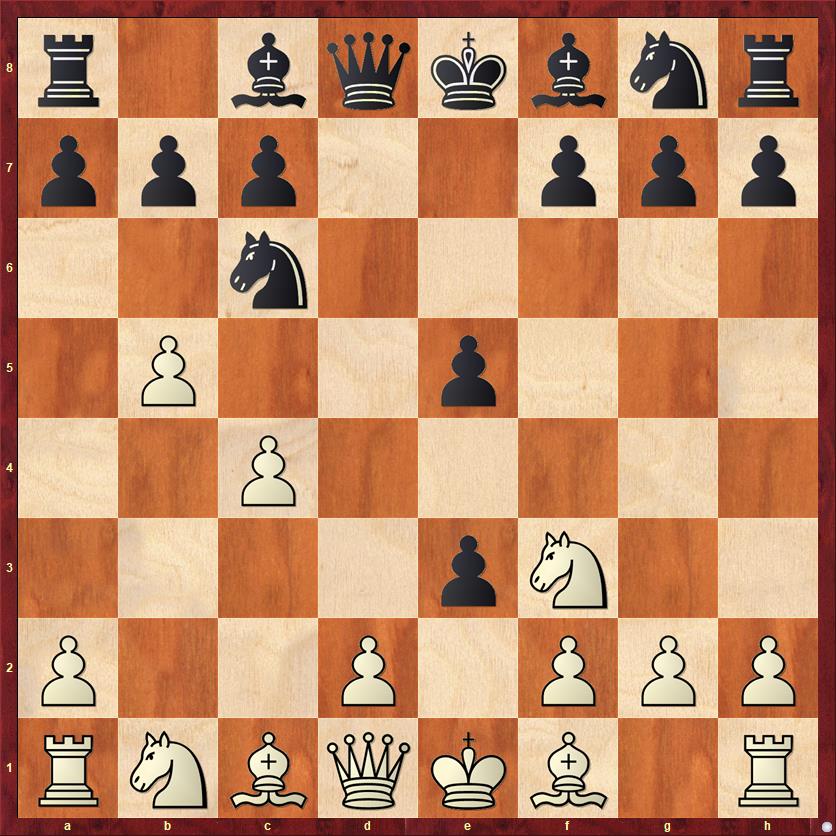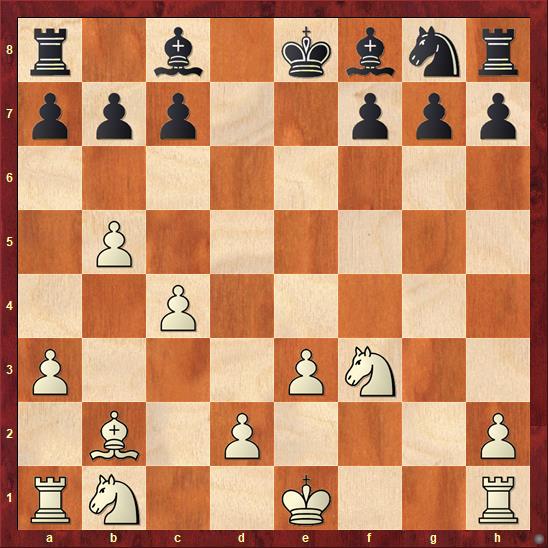Last weekend Gjon Feinstein and I met up for not only our first live chess games of the year, but our first since the pandemic began. Back in the long-gone days B. P. (before pandemic) we used to meet very frequently, at least once every two weeks. Times have sure changed. We saw each other maybe three times in 2021, but those meetings were in groups of three or more people and they were analysis sessions. We didn’t actually play any games.
This time we played four games, semi-blitz games at a time control of game in 7 minutes. Gjon is way better than me at blitz, but the slower time control of G/7 evens up the odds a little bit. On Saturday I actually won two out of four.
But what I really want to talk about is not that I won half of our games, but I discovered an opening Theoretical Novelty! A pretty cool one, too, that involves sacrificing a piece on move six and that is, according to the computer, completely sound. It’s mind-blowing to me that there could still be such a line — but check it out!
Gjon — Dana, Reti Opening
1. Nf3 d5 2. c4 d4 3. e3 Nc6 4. b4 …
All known theory so far, although 4. b4 isn’t the most common move. Gjon hopes to tempt Black into grabbing a pawn with 4. … de 5. fe Nxb4. I think I’ve even played that against him once or twice before, and he won very easily.
Gjon and I have similar styles in one respect: we both value the initiative a great deal and we are willing to sacrifice material to gain the initiative. That’s why he played 4. b4. I asked myself: in this position, is there some way that I can call the shots, rather than letting him call the shots? Yes, there is!
4. … e5! 5. b5 de!

FEN: r1bqkbnr/ppp2ppp/2n5/1P2p3/2P5/4pN2/P2P1PPP/RNBQKB1R w KQkq – 0 6
This is the theoretical novelty. Black offers a piece sacrifice for the purpose of exposing White’s king and taking advantage of the weak dark squares, especially the a7-g1 diagonal and the h8-a1 diagonal. Conveniently there will be a target at the end of each of those diagonals, White’s king an rook.
In our first game, Gjon did not accept the piece sacrifice, but in our second game he did. After 6. bc ef+ 7. Kxf2 Bc5+?! 8. d4! Bg4!? 9. cb Bxd4+ 10. Qxd4 ed 11. baQ Qxa8 we got to a wild position with queen and two pawns versus rook and two minors. I eventually won, but only because he uncharacteristically blundered an exchange later on.
However, the above line is moot because the computer comes up with a major improvement for Black after 7. Kf2: 7. … e4! This threatens to drive away White’s knight and pick up the rook with … Qd4+. White has a couple of options here, 8. Qe2 and 8. cb, but Fritz evaluates both of them as completely equal. It’s again a wild position with many possibilities for both sides, but on general principle I would rather be Black because I have more threats and more active pieces.
In our first game, Gjon elected not to take the piece but instead chose the other consequential move:
6. fe …
Also 6. de is playable, but after 6. … Qxd1+ 7. Kxd1 e4 a lot of material comes off. The position is equal but even worse, it is rather dull — not something Gjon would like at all. His move 6. fe makes a lot of sense. I have to move my knight somewhere, and then how do I keep from losing a pawn?
6. … Nb4!
Damn the torpedoes, and full speed ahead! My knight has no way back, but I’m gambling that he won’t need one.
7. d3 …
There are a couple other important options. First of all, 7. Nxe5? would lead to a catastrophe after 7. … Qh4+. After the game we decided that 7. a3 would probably have been best. After the more or less forced 7. … Nd3+ 8. Bxd3 Qxd3 9. Nxe5 Qe4 10. Bb2 Qxg2 11. Qf3 Qxf3 12. Nxf3 we get to the following rather amusing position.

FEN: r1b1kbnr/ppp2ppp/8/1P6/2P5/P3PN2/1B1P3P/RN2K2R b KQkq – 0 12
I’m not sure I’ve ever seen a position quite like this. Eleven and a half moves into the game, all of Black’s pieces are still on their original squares. Meanwhile, White has made five pawn moves and two piece moves. You could argue that White is seven tempi ahead! Nevertheless, I agree with the computer’s evaluation that the position is about even. Black’s two bishops will be very strong, and White’s advanced pawns could turn into targets.
The next few moves of the game were a little bit ragged (remember, it’s a 7-minute game), so I will not give detailed annotations to them.
7. … Bf5?
Better was 7. … e4, which the computer says is still even.
8. Nxe5? …
Too greedy. The obvious 8. e4 was better. Gjon didn’t play it because he didn’t like the weak dark squares after 8. … Bg4, but 9. Be3! actually protects the dark squares quite nicely.
8. … Qf6 9. Bb2? O-O-O?
As Gjon pointed out to me after the game, 9. … Bd6 simply wins a piece.
10. Qb3 Qg5!
I don’t need to worry about any knight forks on f7, because the weakness of White’s e3 pawn is decisive. The rest of the game is just a slaughter.
11. Kf2 Nf6 12. Nd2 Nxd3+ 13. Bxd3 Bxd3 14. Nxd3 Ng4+ 15. Kg3 Qxe3+ 16. Kxg4 Rxd3 17. White resigns
The computer helpfully points out that I missed a forced mate in three with 16. … h5+ 17. Kf5 g6+ 19. Kf6 Qe7 mate. That’s pretty cute, but in blitz chess it’s generally better to go the barbaric route: first take your opponent’s material, then checkmate.
Of course, the two questions on my mind after I got home were: is this piece sac really sound? And: has anyone played it before? The answer to the first question seems to be yes, as I’ve already explained. I was very surprised to discover that the answer to the second question is no. I looked both on ChessBase and on chess.com, and neither of them had a single game with the position in the first diagram above. According to ChessBase, 4. b4 has been played in 102 master games, and Black played 4. … de (93 times), 4. … Nxb4 (4 times) and 4. … Bg4 (5 times). But Black has never played 4. … e5 in a rated master game.
Why? All of Black’s moves look natural to me, assuming you don’t mind offering a piece sacrifice as early as move 6. In the game above, you can see that all I really had to do was develop all my pieces and the game won itself. My guess is that this has never been played before because Gjon’s move 4. b4 is itself considered a little bit extravagant. Most Black players do not hesitate to grab the pawn with 4. … de and 5. … Nxb4.
However, I think that this knight sac is psychologically a terrific weapon against a White player who wants to seize the initiative with an unclear sacrifice. All of a sudden White finds himself on the defense, with an exposed king and weak squares all over the place, while Black is the one with an attack. The position in diagram two seems to be about the best that White can hope for.
As the (apparent) inventor of the variation 1. Nf3 d5 2. c4 d4 3. e3 Nc6 4. b4 e5 5. b5 de, I guess I get the first crack at naming it. In honor of the New Year, I propose to call it the Twenty-Two Gambit. But if anyone else has a better name, let me know!



{ 3 comments… read them below or add one }
Congrats on the beautiful finding! Delchev’s The Modern Reti has good material on what he calls the risky 4. b4?!, but nothing building on a piece sac.
Out of curiosity, are names like the Mackenzie Gambit and the Santa Cruz Gambit already taken?
MacKenzie madness, Dana’s Drop
I could live with Mackenzie’s Madness. Santa Cruz Gambit would be fine also, but kinda boring. That line that led to diagram two could be the Seven Tempo Gambit, but that wouldn’t be suitable for the variation as a whole.